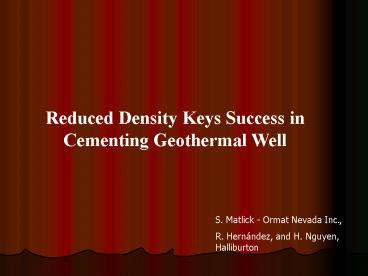Reduced Density Keys Success in Cementing Geothermal Well PowerPoint PPT Presentation
Title: Reduced Density Keys Success in Cementing Geothermal Well
1
Reduced Density Keys Success in Cementing
Geothermal Well
S. Matlick - Ormat Nevada Inc., R. Hernández,
and H. Nguyen, Halliburton
2
Overview
- Background
- Location
- Geology
- Challenges
- Technology and Operations
- Conclusions
3
Background
- ORMAT generates more than 700 MW of power in 22
countries - Including 237 MW in the USA
- - Heber wells
- Beginning 2005 for 10 MW expansion
- 3 new production wells
- 4 new injections wells
- 20 in surface casing form 240 ft to 420 ft
- First 2 wells required 222 excess cement
- First well (well P-12) required 4 top jobs
- Inital volume pumped 328 cuft (50 excess)
- After top jobs 1514 cuft total
4
Location
5
Geology
- Heber Reservoir
- Capping clays above 1,800 ft
- Sedimentary matrix permeability 1,800-5,500 ft
- Fracture permeability below 5,500 ft Seepage loss
6
Challenges
- Providing good cement around surface casing
- Reduce or eliminate cement top jobs
- Factors contributing to challenges
- Rapid penetration rates and pumping rates
(inducing fractures and washouts) - Weak formations could not withstand hydrostatics
pressures of regular cements - Cement set times not adequate
7
Technology and Operations
- Rate of penetration (ROP) and pump rates
- ROP Limited to 60ft/hr
- Pump Rate reduced form 500 gal/min to 350 gal/min
- Density reduction material
- Use of lightweight cement additive (Microspheres)
- Provide early compressive strength
- Have good thermal insulation properties
- Accelerated slurry set
- Use of calcium sulfate
- Aid in lost circulation control
- Impart thixotropic properties
8
Technology and Operations (Contd)
- Flushes/Spacers
- Reactive spacers
- Improve mud displacement and cement bonding
- Control fluid loss
9
Conclusions
- Reducing cement-slurry density
- , decreasing drilling rates and drilling-fluid
pump rates, - accelerating cement-set times, and
- applying reactive flushes ahead of the slurry
- have reduced surface-casing cement costs by about
37.
PowerShow.com is a leading presentation sharing website. It has millions of presentations already uploaded and available with 1,000s more being uploaded by its users every day. Whatever your area of interest, here you’ll be able to find and view presentations you’ll love and possibly download. And, best of all, it is completely free and easy to use.
You might even have a presentation you’d like to share with others. If so, just upload it to PowerShow.com. We’ll convert it to an HTML5 slideshow that includes all the media types you’ve already added: audio, video, music, pictures, animations and transition effects. Then you can share it with your target audience as well as PowerShow.com’s millions of monthly visitors. And, again, it’s all free.
About the Developers
PowerShow.com is brought to you by CrystalGraphics, the award-winning developer and market-leading publisher of rich-media enhancement products for presentations. Our product offerings include millions of PowerPoint templates, diagrams, animated 3D characters and more.

